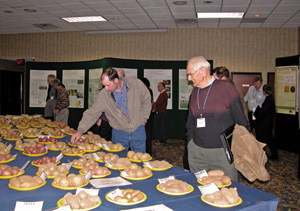
They are the stuff of rural legend, handed down from generation to generation
and through coffee shop grapevines. But are they true? Scott Meers, integrated
crop management specialist with Alberta Agriculture, Food and Rural Development
at Brooks, tackles the most persistent insect myths. Some are based on fact
and others mere coincidence.
Insects always come back to the same field…
Do insect pests have some sort of genetic homing device that allows them to
keep coming back to the same field? It might seem like it, but Meers says there
are good reasons why insects end up where they do.
First, insects are attracted to environmental and food resources that help
them complete their life cycles. Wheat stem sawfly is attracted to grass family
plants, which is why problems evolve near grass around field edges.
 |
| Wheat stem sawfly seems to come back to the same field because it is attracted to grass family plants around field edges. Photos By Emily Watson. |
Other examples of food resources attracting insects include bertha armyworm
to mustard family plants, and Colorado potato beetle to nightshade plants.
"All plants give off volatile chemicals that attract insects, both beneficial
and pests," explains Meers. "You can use that knowledge to help prevent
the pests from completing their life cycles, such as ensuring better weed control
to eliminate hosts."
Field environment also plays a role. Some fields, or areas of fields, are more
prone to certain insects. Meers says that sandy soils tend to harbour more sawflies.
Grasshopper development and reproduction is also favoured on sandy soils. Pale
western cutworms lay eggs in loose soil in the fall.
Weedy fields may also attract insects. Meers says stink bug likes Russian thistle
infested fields. Army cutworm prefers fields with green plants in later fall.
Meers says that insects will not generally travel very far if all the resources
are nearby. Perhaps that is the reason the myth developed in the first place.
"The bottom line is that insects are found in areas where their requirements
for reproduction are met, and are strongly attracted to their host plants or
crops," he says.
Mustards do not have insect problems…
Partially true. Meers says that brown and oriental mustards are not much different
than canola in insect resistance. Generally, research and field observations
have found that yellow mustard differs somewhat from canola, but is not totally
immune or resistant to insects.
Yellow mustard has shown some resistance to cabbage seedpod weevil and flea
beetle. "Some insects may be less of a problem in yellow mustard fields,"
says Meers. "However, it is not totally immune to insect problems and careful
scouting still needs to be carried out."
Spraying insects at low levels will prevent population
from building up…
Not only is this a myth, but Meers says it may actually backfire by also eliminating
the insect pests' natural enemies. "These guys are our friends and you
don't want to eliminate them."
Meers explains there are three main factors that determine insect populations:
availability and quality of food resources, weather and the insect's natural
enemies. The interaction of these factors determines the population level of
a specific insect.
Natural enemies of insects are categorized into predators, parasites and diseases.
For example, predators like the funnel spider can prey on a host of insects.
The Therevidae larvae preys on wireworm. The parasitoid Bracon cephi
attacks the wheat stem sawfly larvae in Canadian wheat fields and there are
entomopathogens like a fungus that grows on and kills grasshoppers.
"These natural enemies control the pests to keep everything in balance.
When a pest outbreak does occur, the natural enemies also cycle up, but usually
lag behind the pest for a few years," explains Meers.
 |
| Yellow mustard has better resistance to flea beetle than canola. |
Meers cautions that a pesticide application may control a natural enemy and
allow the pest to escape its natural controls. In addition, secondary pests
like the cotton aphid may increase in numbers, causing additional problems.
"Only spray insects to protect crops, not to control populations. This
requires careful monitoring and the use of economic thresholds," cautions
Meers.
Wheat stem sawfly causes white heads in wheat…
Meers says there are many factors behind white heads in wheat, including take-all
root rot, wheat stem maggot, Say's stink bug, fusarium head blight, hail, fertility
and herbicide effects and frost. Wheat stem sawfly is not one of the causes
of white heads.
A common cause of white heads in wheat is take-all root rot disease. The disease
kills headed-out plants and in spring sown wheat, a 62 percent infection of
take-all reduced yields by 50 percent. This disease is progressive, spreading
from plant to plant throughout the growing season.
"The key to understanding insects is to find out more about their habits,
life cycles and management control programs," says Meers. "There are
always exceptions to the rules, but don't fall back on old myths when you see
something puzzling in the field. Consult with entomologists and find out if
you really do have a problem. Then take appropriate action based on sound agronomic
and economic reasons."